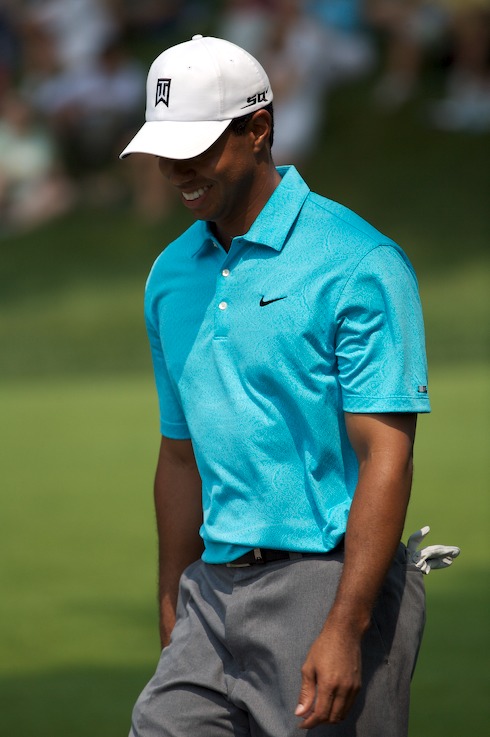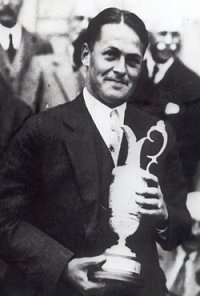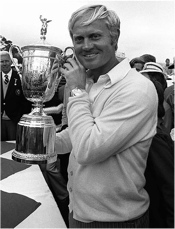 Here it is two weeks until the U.S. Open at Bethpage Black. Two weeks ago, the media was reporting on the recent demise of Tiger Woods and speculating that this year’s Open might be the most wide open in years. This week, following Tiger’s 14 of 14 fairways hit performance (and 87.5% for the week) at the Memorial, they are declaring him the winner even before the first tee shot is struck.
Here it is two weeks until the U.S. Open at Bethpage Black. Two weeks ago, the media was reporting on the recent demise of Tiger Woods and speculating that this year’s Open might be the most wide open in years. This week, following Tiger’s 14 of 14 fairways hit performance (and 87.5% for the week) at the Memorial, they are declaring him the winner even before the first tee shot is struck.
If they switched opinions any faster, they’d all be in traction with whiplash. Still, I wouldn’t go betting the farm against Tiger, either… and maybe not even dinner.
I love the U.S. Open. Well, to be honest, I love the Masters and the British Open, too. To be fair, I do like the PGA Championship, but she needs to love herself and stop imitating others before she and I can have a real relationship. Maybe bring back match play… I don’t know.
But I was talking about the U.S. Open. As Roy McAvoy pointed out in Tin Cup, the U.S. Open is the most democratic of all the majors (though arguably tied with that “other” wonderful Open Championship). If you qualify, you’re in. Heck, even if you don’t have the game to make the real thing, you can still play the course virtually. (Actually, I think I have a better chance of breaking 100 on the real course than on the virtual one.)
If you can’t wait for the U.S. Open either, here are five things you might not know about the Championship.
Number Five: The First U.S. Open
 The USGA held the first U.S. Open on Oct. 4, 1895, at the nine-hole course of Newport (R.I.) Golf and Country Club. Only 11 participants competed in what was basically a warm-up act for the first U.S. Amateur, which was held that same week on the very same course. Ten professionals and an amateur made the required four circuits of the Newport course.
The USGA held the first U.S. Open on Oct. 4, 1895, at the nine-hole course of Newport (R.I.) Golf and Country Club. Only 11 participants competed in what was basically a warm-up act for the first U.S. Amateur, which was held that same week on the very same course. Ten professionals and an amateur made the required four circuits of the Newport course.
The assistant at the host course, 21-year-old Horace Rawlins, won with a 36-hole score of 173. He took home $150 dollars, a gold medal, and custody of the Open Championship Cup for his club for one year. Winners of the U.S. Open still receive the gold medal and custody of the cup (they don’t get to keep the real one), but they also take home a wee bit more ($1,350,000 in 2008).
Number Four: Who’s In?
The 2009 U.S. Open field consists of:

- Winners of the U.S. Open Championship the last 10 years (1999-2008).
- Winner and runner-up of the 2008 U.S. Amateur Championship (must be an amateur).
- Winners of the Masters Tournament the last five years (2005-2009).
- Winners of the British Open Championship the last five years (2004-2008).
- Winners of the PGA of America Championship the last five years (2004-2008).
- Winner of the 2009 Players Championship.
- Winner of the 2008 U.S. Senior Open Championship.
- 15 lowest scorers and anyone tying for 15th place at the 2008 U.S. Open Championship.
- Top 30 money leaders from the 2008 final official PGA Tour money list.
- Those qualifying for the season-ending 2008 Tour Championship.
- Top 15 money leaders from the 2008 final official PGA European Tour money list.
- Top 10 money leaders from the 2009 official PGA Tour money list, through May 25 (must have filed an entry by April 29).
- Any multiple winner of PGA co-sponsored events whose victories are considered official from June 2, 2008 through June 14, 2009.
- Top five money leaders from the 2009 official PGA European Tour money list, through May 25.
- Top two money leaders from the 2008 final official Japan Golf Tour money list, provided they are within the top 75 point leaders of the World Ranking at the end of the year.
- Top two money leaders from the 2008 final official PGA Tour of Australia money list, provided they are within the top 75 point leaders of the World Ranking at the end of the year.
- Top 50 point leaders from the current World Rankings, as of May 25.
- Any player whom the USGA selects for an exemption on the basis of his playing record (must have filed an entry by April 29).
- Plus, those who earn entry through a sectional qualifying tournament.
Though this sounds like it must amount to 500 or more qualifiers, there are only 156 players in the field.
By the way, those exemptions from the USGA… They are not used all that often, especially these days. The last international player to receive an exemption into the U.S. Open was Masashi (Jumbo) Ozaki from Japan. The USGA last granted a special exemption in 2005 to Nick Price (who, yes, is international but had been playing in the States for years). Price made a good showing with a T9 finish. Nick Faldo was granted an exemption in 2002 at Bethpage.
And if you want to see the actual list of players, you’ll find it here.
Number Three: The Playoffs
 Tiger Woods’ victory over Rocco Mediate last year in a playoff was certainly not an aberration in the U.S. Open. Playoffs have long had a role in the Open.
Tiger Woods’ victory over Rocco Mediate last year in a playoff was certainly not an aberration in the U.S. Open. Playoffs have long had a role in the Open.
The first U.S. Open playoff took place in 1901 when Willie Anderson bested Alex Smith 85-86 in an 18-hole playoff and in the process amassed the still standing highest winning score of 331 total strokes at Myopia Hunt Club in South Hamilton, Massachusetts.
Robert T. Jones, Jr., won two of his four U.S. Opens in playoffs (1923 over Bobby Cruickshank 76-78 and 1929 in a 36-hole playoff over Al Espinosa 141-164). Bobby Jones also lost twice in U.S. Open playoffs (1925 in a second 18-hole playoff to William Macfarlane 75/72-75/73 and in 1928 in a 36-hole playoff 143-144).
The USGA did away with 36-hole playoffs after Billy Burke and George Von Elm tied after the first 36 holes and had to play another in 1931 (Burke pulled it out in a squeaker 149/148 to 149/149).
Number Two: The Highest and the Fewest
Highest cut line since World War II: 155 (+15) The Olympic Club, San Francisco, 1955.
Highest score on one hole: Ray Ainsley made a 19 on the par-four 16th hole at Cherry Hills C.C., Englewood, Colorado, in 1938.
 Highest winning score: In 1972, Jack Nicklaus took 290 strokes over 72 holes at Pebble Beach.
Highest winning score: In 1972, Jack Nicklaus took 290 strokes over 72 holes at Pebble Beach.
Fewest subpar rounds by the field for the Championship: 2 — Oakland Hills C.C., Birmingham, Mich., 1951.
Number One: The Last Amateur
The last amateur to win the U.S. Open was not Bobby Jones, who last won in 1930. No, the last amateur to win the Open was John Goodman in 1933, years before his role as Mighty Mack McTeer in Blues Brothers 2000. OK, not that John Goodman.
John G. Goodman, the golfer and insurance salesman, was born in 1909 and passed away in 1970. Like Bobby Jones, he had a long career as an amateur, though Goodman eventually did turn pro in 1960. In addition to the U.S. Open, Goodman also won the US Amateur in 1937. There is a golf course in Omaha named for him.
For the record, the other amateurs to win U.S. Opens were Francis Ouimet (1913), Jerome D. Travers (1915), and Charles “Chick” Evans, Jr. (1916).
Photo Credits: © The Sand Trap .com, © St. Andrews .org, and Walter Iooss Jr./SI.

This is great. I love articles that educate us about the history of the sport or how various aspects of tournaments (eg. field selection) etc. work. Thank you.
Would you consider this topic. The PGA Tour constantly claims that 1 Billion has been contributed to charities, essentially taking credit for the contributions. But are these contributions from the PGA or are these contributions made by patrons or visitors to the tournaments (the general public) who buy merchandise, drinks, food etc. Doesn’t the local county & state also give up sales tax to facilitate the tournaments. Shouldn’t the credit for contributions to charity not go the General public, viewers, state and local governments that give up sales tax revenue.
Why I ask you and the press is the PGA Tour permitted to steal credit for your and my contributions. They are simply hosting their tourney (their product or service), they are not making the charitable contribution are they. They are robbing us of our contribution to the sport.
Could this be an investigative story and an opportunity to hold the PGA Tour accountable to its viewers.
Paul raises and interesting point. The charity thing has never sat well with me. Golf, by cost and perception, is a rich mans game, I assumed the charity thing was to take the edge off of that image.
But it occurred to me that the only way they could get so many people to volunteer and help 50 spoiled brats whack a ball around for big money was to tie the volunteering to crying kids. Then one might feel good about carrying the water for Tiger while he wins another million bucks. I can’t imagine for the life of my why anyone would spend their time and energy volunteering to help things go smoothly for the PGA -a for profit organization. Can’t the afford it themselves? If they can’t shouldn’t the cut the purse and pay people? I digress.
I suspect the billion is an aggregation of donations, with the largest parts coming from corporate sponsors, pro-am fees, and the like, which, in truth would not take place without the ball whacking for big money.
The billion dollars figure is accumalated over the past 25 years I think, but the main point is that why is the PGA Tour getting credit for our contributions.
Secondly isn’t it false and misleading advertising to take credit for contributions that the Tour itself has not made and this from an organization that promotes and plays golf.
I am curious why the FTC hasn’t been involved.
The press certainly will not raise the issue, the represent the sport and the Tour more than they represent the citizens.
I hope that SandTrap will have the courage to pursue this.
Great article! Pro golf must be the most mysterious form of professional sporting event out there. Maybe pro tennis is the same way? Look at those qualifying rules, and just for one tournament! Crazy. I’m bumfuzzled, and I follow the game much closer than most.
Regarding the whole charity subject mentioned by Paul, I agree that a balancing of accounts is in order.
The whole ‘volunteering’ aspect of tourneys, though, has me thinking. If one were able to ‘volunteer’ at other professional sporting events where you were pretty much guaranteed some elevated access to the competitors, wouldn’t the line form for miles to do so? No one is forcing someone to volunteer, and my guess is that those who do do it for the benefits they receive – free access to the grounds, the players, the event, souvenirs, etc.
Quick note about Ray Ainsley, who made the record-setting 19 in the ’38 Open (from the USGA Championship Database):
And we thought today’s professionals didn’t know the rules…